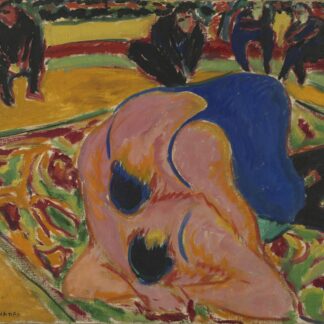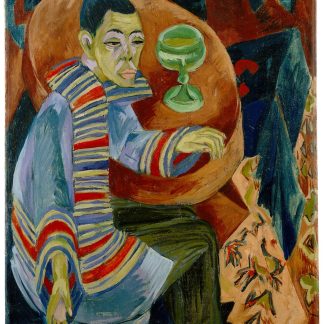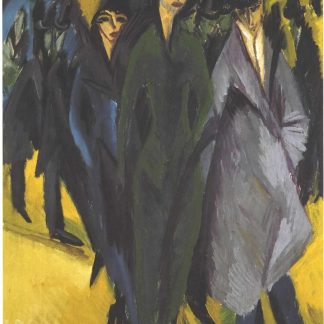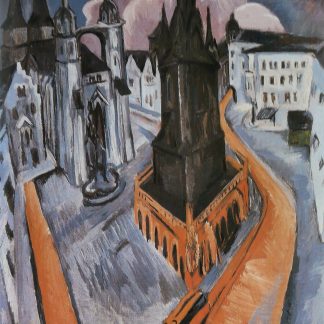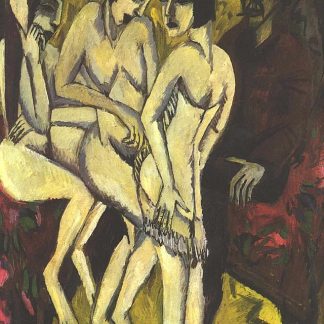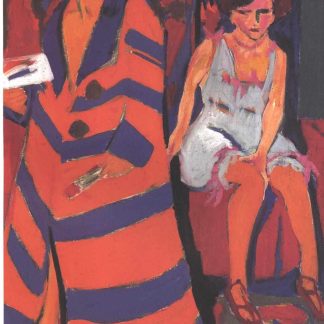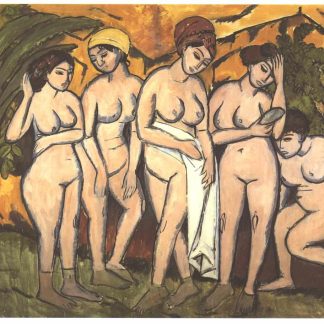Ernst Ludwig Kirchner (1880-1938) was a German painter and printmaker who played a leading role in the Expressionist movement. Born in Aschaffenburg, Kirchner studied architecture before turning to art. He moved to Dresden in 1905, where he founded the artist group Die Brücke (The Bridge) with several other young artists, including Emil Nolde and Max Pechstein. The group sought to break with academic traditions and explore new ways of expressing emotion and subjectivity in art.
Kirchner’s style is characterized by bold, colorful forms and a sense of anxiety and tension. He often depicted urban scenes and the modern world, including cafes, streets, and dance halls. His work is marked by a certain restlessness, reflecting the social and political upheaval of his time. Kirchner’s experiences serving as a medic during World War I also had a profound impact on his art, leading to a darker and more introspective period in his work.
Despite his success, Kirchner’s personal life was troubled, and he struggled with depression and addiction. In 1937, the Nazi regime labeled his work as “degenerate” and removed it from museums. The following year, Kirchner took his own life in Switzerland. Today, his work is celebrated for its innovative style and bold expressionism, and is considered a major influence on modern art.
Showing all 9 results
-

Wrestlers In A Circus 1909. German. Oil On Canvas.
Kirchner, Ernst LudwigUncategorized, Best Sellers, Giclee Prints
From $28.69 Select options This product has multiple variants. The options may be chosen on the product page -

Ernst Ludwig Kirchner – The Red Tower (La Tour Rouge)
Kirchner, Ernst Ludwig $165.60 Add to cart -

Portrait of Hans Frisch (Herrenbildnis_-_Hans Frisch)
Kirchner, Ernst Ludwig From $28.69 Select options This product has multiple variants. The options may be chosen on the product page -

The Drinker – Self Portrait (Der Trinker – Selbstbildnis)
Kirchner, Ernst Ludwig From $28.69 Select options This product has multiple variants. The options may be chosen on the product page -

Women on the Street
Kirchner, Ernst Ludwig From $28.69 Select options This product has multiple variants. The options may be chosen on the product page -

The Red Tower in Halle (La Tour Rouge)
Kirchner, Ernst Ludwig From $28.69 Select options This product has multiple variants. The options may be chosen on the product page -

Das Urteil des Paris
Kirchner, Ernst Ludwig From $28.69 Select options This product has multiple variants. The options may be chosen on the product page -

Self Portrait With a Model
Kirchner, Ernst Ludwig From $28.69 Select options This product has multiple variants. The options may be chosen on the product page -

Five Bathing Women at a Lake
Kirchner, Ernst Ludwig From $28.69 Select options This product has multiple variants. The options may be chosen on the product page
Showing all 9 results

